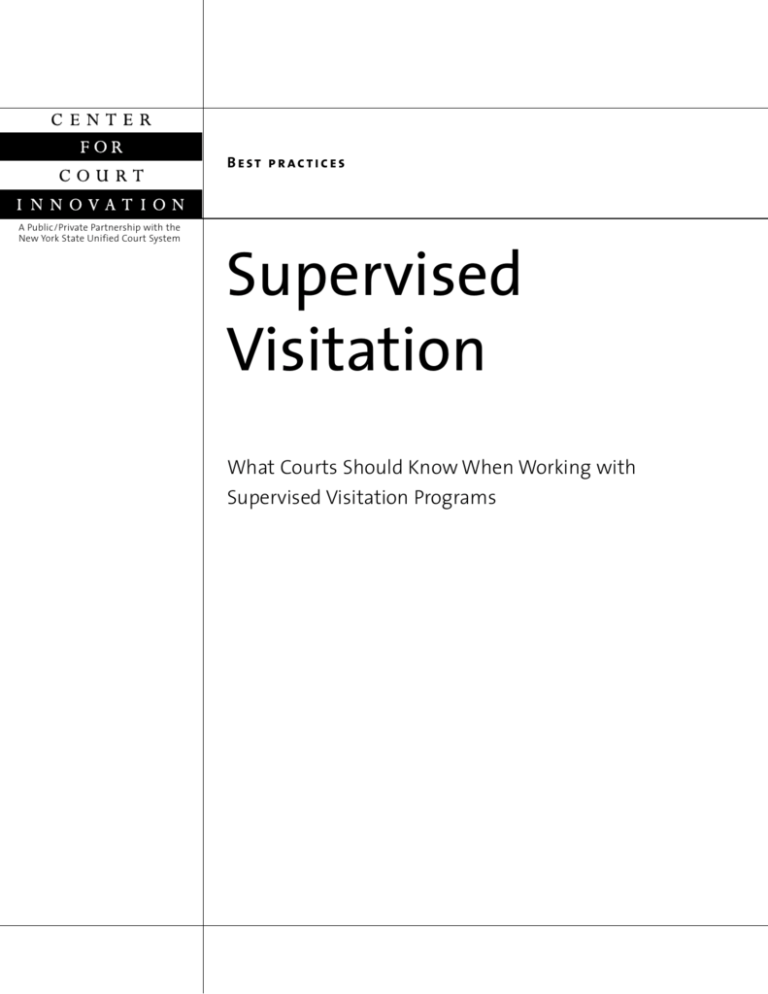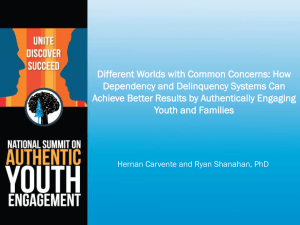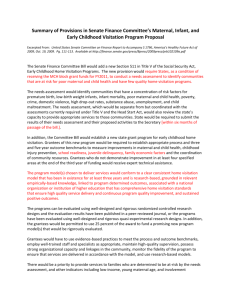Supervised Visitation - Center for Court Innovation
advertisement

B e st p r a c t i c e s A Public/Private Partnership with the New York State Unified Court System Supervised Visitation What Courts Should Know When Working with Supervised Visitation Programs Written by Samantha Moore Kathryn Ford 2006 This publication was supported by the New York State delegation to the United States Congress through funding provided by the Bureau of Justice Assistance, Office of Justice Programs, U.S. Department of Justice, under Grant No. ww-02-56-26-32. Points of view and opinions in this document are those of the authors and do not necessarily represent the official position or policies of the U.S. Department of Justice. S U P E R V I S E D V I S I TAT I O N What Courts Should Know When Working With Supervised Visitation Programs Introduction After separating from their abusive partners, as many as 60 percent of domestic violence survivors experience ongoing threats and intimidation in connection with issues regarding their children.1 One recent study indicated that more than one third of battered women are subjected to severe psychological abuse or threats during visitation and exchanges.2 While orders of protection can help to ensure that domestic violence perpetrators have limited access to survivors, offenders often use informal visitation arrangements as an opportunity to continue to assault, harass, stalk and emotionally abuse their partners. In addition, due to the significant overlap between domestic violence and child maltreatment, some parents may abuse or attempt to abduct their children during visits. When family violence persists in this way, children continue to witness and be adversely affected by it. Because of these risks, courts often find it necessary to require that visitation between abusive parents and children is supervised. Supervised visitation is contact between a non-custodial parent and his or her child in the presence of a third party who observes the visit and ensures the child’s safety. In domestic violence cases, visits voluntarily supervised by friends and family in their homes can be fraught with danger for the child and victim, as well as the monitor. For this reason, visitation supervised by a neutral, professional third party, with the capacity to enforce effective safety measures, is the optimal choice for the court. In most communities, these services are provided by social service agencies, such as victim service and child welfare organizations, and can range from one-onone supervision with a monitor continuously nearby, to visits in large rooms supervised by several monitors. Although many communities contend with long waiting lists and a limited supply of providers, it remains critical for courts to order agencybased visitation in cases involving concerns for the safety of the children and/or the custodial parent. Supervised visitation can be an important tool for avoiding further incidents of domestic violence. However, increased safety cannot be guaranteed by simply 1. Magen, R.H., Conroy, K., McCart Hess, P., Panciera, A. & Levy Simon, B. (1995). Evaluation of a protocol to identify battered women during investigations of child abuse and neglect. Paper presented at the Fourth International Family Violence Research Conference, Durham, N.H., July 22, 1995. 2. O'Sullivan, C.S., King, L.A., Levin-Russell, K. & Horowitz, E. (2006). Supervised and unsupervised access in domestic violence cases: Court orders and consequences. Executive summary submitted to the National Institute of Justice, March 2006. 1 Center for Court Innovation ordering supervised visitation. Courts must take other measures to ensure the continued appropriateness of the programs they utilize. For instance, courts can make sure that the programs they work with have specialized safety and security measures and staff that is well trained in the dynamics of domestic violence, the impact of this violence on children and the importance of holding batterers accountable for their actions. In addition, courts can work with local providers to develop formal protocols that clearly delineate security and confidentiality procedures, outline a strategy for maintaining strong relationships between service providers and law enforcement agencies, and require ongoing staff training on domestic violence. This paper highlights a number of practices used by exemplary supervised visitation programs and the courts, and is intended for judges, court administrators and their community partners in an effort to reduce the risk of violence for survivors and their children. These recommendations are based upon information gathered from New York State supervised visitation providers, program observations, a review of current literature in the field, and the Supervised Visitation Network, a national coalition of providers that disseminates best practice standards. While implementing all of these suggestions may be difficult, this paper aims to give courts and programs a framework for ongoing coordination. There is much that courts can do to encourage the use of practices that increase victim safety and offender accountability during visitation. The following recommendations have been developed as a guide for courts working with programs on addressing the needs of families in crisis. Communication Court and supervised visitation program staff should meet regularly and establish a close working relationship. This will help to ensure that expectations are met on both sides: that the program understands the court’s needs and concerns and that the court understands the program’s issues and experience. The program must receive vital information in a timely manner from the court while providing the court with a clear and detailed understanding of their policies and procedures. To maximize safety, providers must also supply the court with a clear set of criteria regarding appropriate referrals. Courts should provide programs with the following information when ordering visitation: • Actual language in the order that mandates the referral to the supervised visita- tion center; • The specific services to be provided (e.g., supervised visitation or supervised exchange); • Who may have contact with the children; • The duration and frequency of contact; • Who will pay for the services; and • The type and frequency of reporting about the progress of visitation that the court requires. 2 Supervised Visitation Court staff should arrange to have a copy of the order of protection and any other orders that are in effect, as well as any written records of allegations of domestic violence or child abuse, sent to the program. It is vital that these orders are shared with all program staff, that copies are kept on file at the site, and that security officers familiarize themselves with the orders. Courts should also ensure that they are receiving reports on a regular basis from the program, especially prior to any court appearances or compliance monitoring. Reports from supervised visitation programs should include the following information: • The names of the custodial parent, non-custodial parent and child(ren) and the case docket number; • The name of the person who provided the supervision; • The visitation schedule, including number of visits scheduled and number of visits facilitated (specifying date, time and duration of contact); • The number of missed visits or times either parent arrived late and an explanation of the circumstances; • A summary of activities engaged in by the parent and child; and • A description of any interventions made during the contact and the reasons, especially if there was an early termination of the visit. It is important that staff strive for objectivity and refrain from offering interpretations or recommendations about custody and visitation in their reports to the court. Security: Partnerships, Physical Space and Confidentiality Strong partnerships with local law enforcement agencies are crucial to keeping domestic violence survivors and their children safe during visitation—especially should an emergency situation arise. Some programs have written protocols that describe what responses can be expected from the local police or sheriff's department (including the priority that will be accorded to requests for assistance). If your local program does not have such a protocol, contact the Center for Court Innovation for examples. Maintaining a safe and secure physical space is another vital component of supervised visitation services. Courts and visitation sites can develop written protocols that outline the following safety measures for referred domestic violence cases: • The process of terminating visits when program rules have been violated and safety is in jeopardy; • The procedures for informing all staff, including security officers, of protective orders; • Arrival and departure protocols that minimize the risk of contact between custodial and non-custodial parents (i.e., arranging for the victim to drop off the 3 Center for Court Innovation child 15 minutes before the offender arrives and requiring the offender to stay at the program site for 15 minutes after the victim and child leave); • A physical layout that keeps custodial and visiting parents separate (i.e., different entrances and waiting rooms for victims and offenders); • A plan for weapon screening (ideally using metal detectors) and disarmament of parents by security staff; • A protocol for consistent monitoring of the security system, facility and grounds for safety risks; and • Protocols that maintain confidentiality for the custodial parent and child— including addresses, telephone numbers, schools, and workplaces. Training Ongoing training for supervised visitation staff on the unique dangers raised by domestic violence perpetrators is key to ensuring the safety and comfort of the child and custodial parent. Courts may hold cross trainings for agency staff, security officers and others on domestic violence issues. It is recommended that all staff be provided with the training necessary to identify and effectively respond to the following safety risks: • Repeated violations of the terms of visitation; • Severe distress of the child in response to visitation; • Indications that the violent parent has threatened to harm or flee with the child; and • Volatile situations that arise during visitation. Court and staff training should also encompass the following topics: • The importance of confidentiality for all parties; • The potential use of visitation as a forum for continuing abuse; • The dynamics of domestic violence; • The impact of domestic violence on children; • Legal interventions in family violence cases, such as orders of protection; • The safety concerns that may arise when victims seek an order of protection, separation agreement, divorce, child support or alimony, or attempt to modify the terms of custody and visitation; and • Typical batterer behavior and how these behaviors may be manifested during supervised visits, including: Testing or violating program rules; Requesting “special privileges” such as unsupervised time with children; Violating orders of protection; Attempting to bring weapons to the program; Denial or minimization of abusive behavior; Blaming partner for the visitation’s being supervised; Attempts to control or manipulate staff; 4 Supervised Visitation Attacking the parenting skills of the custodial parent; Making covert or overt threats to hurt or abduct the child or adult victim; Using children as informants about current living situation, phone numbers, schools, etc; Stalking the victim and child upon arriving or departing the program; Financial abuse/manipulation; Telling the child that a beloved pet has died or had to be given away because the child is no longer at home; Physical violence; Destruction of property (e.g., slashing tires); and Making suicide threats. Courts and program staff should also be alerted to the danger of using offender behavior and parent-child interactions during visits to assess the safety risk to adult victims and children. Batterers may have “dual personalities” that can be charming in public and brutal behind closed doors, and most can exhibit appropriate parenting for brief periods while being closely monitored. In addition, children’s interactions with a parent who has been abusive can have many possible meanings that are difficult to discern from observation alone. For example, a child who hugs and plays with their non-custodial parent may feel safe only in the supervised setting or may be allying themselves with the violent parent to feel powerful or minimize the risk of future abuse. Awareness of these dynamics can help to ensure the objectivity of supervised visitation reports and facilitate more informed decision-making in custody and visitation matters. Conclusion While there are no guarantees of safety in these volatile cases, supervised visitation centers, working in conjunction with courts, can minimize the risk of further violence to the victim and ensure offender accountability by implementing practices that address the needs of domestic violence survivors and their children. 5 Center for Court Innovation The winner of an Innovations in American Government Award from the Ford Foundation and Harvard's John F. Kennedy School of Government, the Center for Court Innovation is a unique public-private partnership that promotes new thinking about how courts and criminal justice agencies can aid victims, change the behavior of offenders and strengthen communities. In New York, the Center functions as the State Court System's independent research and development arm, creating demonstration projects that test new approaches to problems that have resisted conventional solutions. The Center’s problem-solving courts include the nation’s first community court (Midtown Community Court), as well as drug courts, domestic violence courts, youth courts, mental health courts and others. Beyond New York, the Center disseminates the lessons learned from its experiments, helping courts across the country and the world launch their own problemsolving innovations. The Center contributes to the international conversation about justice through a variety of written products, including books, journal articles and white papers like this one. The Center also provides hands-on technical assistance, advising court and criminal justice planners across the globe. Current areas of interest include problem-solving justice, community prosecution, court technology, drug treatment courts, domestic violence courts, mental health courts and research/evaluation. For more information, call 212 397 3050 or e-mail info@courtinnovation.org. Center for Court Innovation 520 Eighth Avenue, 18th Floor New York, New York 10018 212 397 3050 Fax 212 397 0985 www.courtinnovation.org A Public/Private Partnership with the New York State Unified Court System






